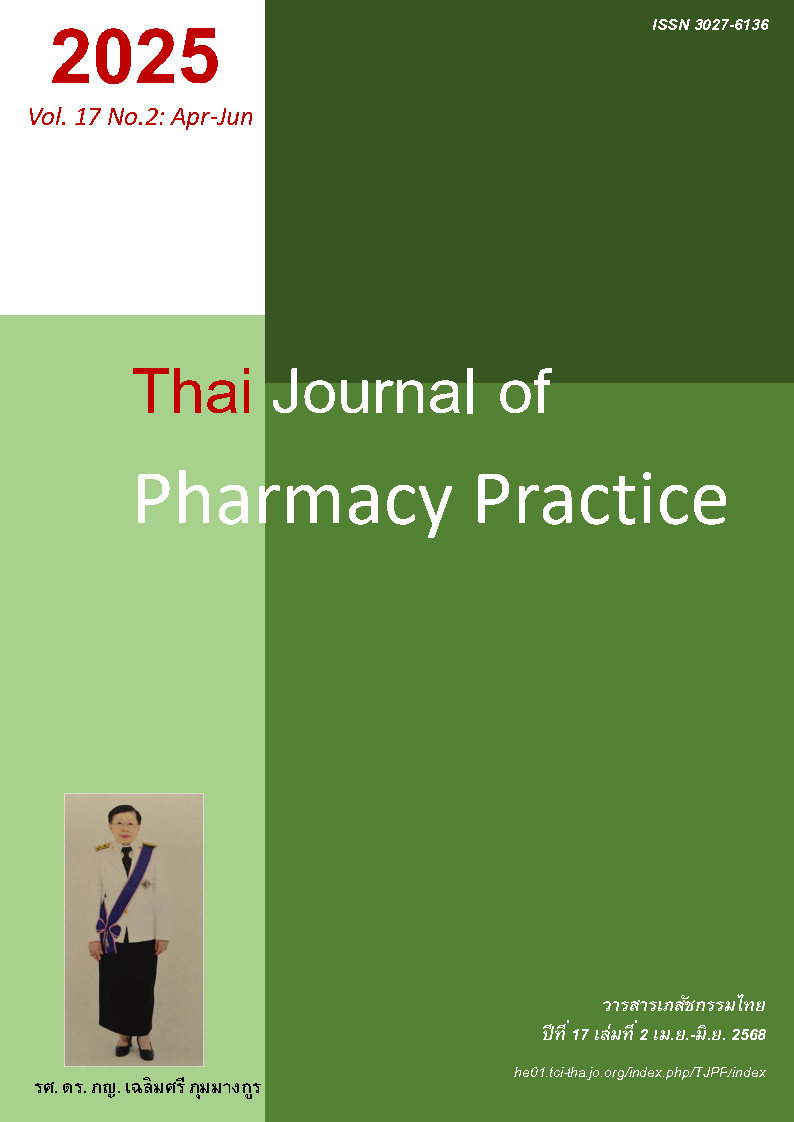การรับรู้ข่าวสารและอันตรายเกี่ยวกับการปนเปื้อนสารเคมีกำจัดศัตรูพืช และวิธีการล้างผักคะน้าของผู้บริโภค ณ ตลาดหนองแคน อำเภอเมืองร้อยเอ็ด
Main Article Content
บทคัดย่อ
วัตถุประสงค์: เพื่อศึกษาการรับรู้ข่าวสาร การรับรู้อันตราย ประสบการณ์การได้รับอันตราย ความรู้เกี่ยวกับสารเคมีกำจัดศัตรูพืช และวิธีการล้างทำความสะอาดผักคะน้าก่อนนำมาบริโภคของผู้บริโภค ณ ตลาดหนองแคน อำเภอเมืองร้อยเอ็ด วิธีการ: การศึกษานี้เป็นการวิจัยเชิงสำรวจ กลุ่มตัวอย่าง คือ ผู้บริโภคผักคะน้าที่มีอายุตั้งแต่ 18 ปี ถึง 65 ปีที่ซื้อผักคะน้าในตลาดหนองแคน อำเภอเมือง จังหวัดร้อยเอ็ด และเป็นผู้ที่เตรียมผักคะน้าก่อนนำไปประกอบอาหารรับประทานเองในครัวเรือน การศึกษาใช้วิธีการเลือกตัวอย่างแบบบังเอิญจำนวน 372 คน การศึกษาใช้แบบสอบถามเพื่อเก็บข้อมูลระหว่างเดือน สิงหาคม ถึง ธันวาคม 2564 ผลการวิจัย: ตัวอย่างร้อยละ 87.6 เคยได้รับข้อมูลข่าวสารเกี่ยวกับสารเคมีกำจัดศัตรูพืช ตัวอย่างร้อยละ 92.7 รับรู้ว่าสารเคมีกำจัดศัตรูพืชที่ปนเปื้อนในผักคะน้าเป็นอันตรายต่อสุขภาพ ตัวอย่างร้อยละ 9.7 เคยได้รับอันตรายจากสารเคมีกำจัดศัตรูพืชที่ปนเปื้อนในผักคะน้า โดยมีอาการต่างๆ ดังนี้ คือ คลื่นไส้/อาเจียน (9 คน) ท้องเสีย (7 คน) วิงเวียน/เวียนศีรษะ (6 คน) ปวดศีรษะ/มึนงง/หน้ามืด (3 คน) ปวดท้อง (3 คน) อาหารเป็นพิษ (1 คน) ผื่นแดง (1 คน) ระคายคอ (1 คน) และคันริมฝีปาก (1 คน) ตัวอย่างมีคะแนนเฉลี่ยความรู้เกี่ยวกับสารเคมีกำจัดศัตรูพืชเท่ากับ 7.8±1.6 (คะแนนเต็ม 10) ตัวอย่างทุกคนได้ล้างทำความสะอาดผักคะน้าก่อนการบริโภค วิธีการล้างแบ่งได้ 3 กลุ่ม คือ 1) ล้างด้วยน้ำและแช่ด้วยน้ำ 2) ล้างด้วยน้ำและแช่ด้วยน้ำผสมสารต่าง ๆ อีก 1 ชนิด และ 3) ล้างด้วยน้ำและแช่ด้วยน้ำผสมสารต่างๆ มากกว่า 1 ชนิด สรุป: ตัวอย่างส่วนใหญ่รับรู้ข่าวสารและอันตรายเกี่ยวกับสารเคมีกำจัดศัตรูพืช ตัวอย่างบางส่วนเคยได้รับอันตรายจากสารเคมีกำจัดศัตรูพืชที่ปนเปื้อน ตัวอย่างมีความรู้เกี่ยวกับสารเคมีกำจัดศัตรูพืชโดยสามารถตอบคำถามได้ถูกต้อง ตัวอย่างทุกคนล้างผักคะน้าก่อนการบริโภค ข้อมูลจากงานวิจัยนี้สามารถนำไปสร้างโปรแกรมให้ความรู้แก่ผู้บริโภคเพื่อป้องกันอันตรายและลดการปนเปื้อนสารเคมีกำจัดศัตรูพืช
Article Details

This work is licensed under a Creative Commons Attribution-NonCommercial-NoDerivatives 4.0 International License.
ผลการวิจัยและความคิดเห็นที่ปรากฏในบทความถือเป็นความคิดเห็นและอยู่ในความรับผิดชอบของผู้นิพนธ์ มิใช่ความเห็นหรือความรับผิดชอบของกองบรรณาธิการ หรือคณะเภสัชศาสตร์ มหาวิทยาลัยสงขลานครินทร์ ทั้งนี้ไม่รวมความผิดพลาดอันเกิดจากการพิมพ์ บทความที่ได้รับการเผยแพร่โดยวารสารเภสัชกรรมไทยถือเป็นสิทธิ์ของวารสารฯ
References
Srimuk S. The impact of the use of agricultural chemicals in Thailand [online]. 2013 [cited Sep 16, 2019]. Available from: library.senate.go.th/document /Ext6409/6409657_0002.PDF
Thai Civil Rights and Investigative Journalism (TCIJ News Team). New from 11 years of Thailand imported 1.66 million tons of agricultural chemicals, and 246 billion baths, with an average of 4 illnesses per year [online]. 2019 [cited Jul 22, 2019]. Available from: www.tcijthai.com/news/2019/10/scoop/9456
Department of Disease Control, Bureau of Epidemiology. Annual epidermiological surveillance report 2020 [online]. 2020 [cited Jul 7, 2021]. Available from: apps-doe.moph.go.th/boeeng/down load/AW_AESR_2563_MIX.pdf
Department of Disease Control. Illness situation from toxic chemical pesticides Year 2001-2017 [online]. 2019 [cited Jul 7, 2021]. Available from: ddc.moph .go.th/uploads/files/89c294f74b806af79b24cacd7fb58b7f.pdf
Office of Agricultural Regulation. Quantity of imported pesticides between 2008 and 2022 [online]. 2023 [cited Oct 5, 2023]. Available from: www.doa.go.th/ ard/?page_id=386
Phakkasama P, Saisin S, Suthin, Somon. Detection of organophosphate and carbamate pesticides residues in vegetables in Samutprakarn Province. APHEIT Journal 2016; 5: 22-30.
Liaotrakoon W, Liaotrakoon V, Peanleangchep P, Duamkhanmanee R. Detection of organophosphate and carbamate pesticide residues in fresh vegetables in Phra Nakhon Si Ayutthaya Province and effectiveness of washing methods pesticide residues in kale. King Mongkut's Agricultural Journal 2020; 38: 131-8.
Bureau of Food Safety Extension and Support. Report on food control situation for fiscal year 2010-2017 [online]. 2017 [cited Jul 11, 2020]. Available from: www.oic.go.th/FILEWEB/CABINFOCENTER1 7/DRAWER002/GENERAL/DATA0001/00001432.PDF
Thailand Pesticide Alert Network (Thai-Pan). Fruit and vegetable inspection results found toxic residues in fruits and vegetables in 2019 [online]. 2019 [cited Jul 11, 2020]. Available from: thaipan.org/action/ 1107
Thailand Pesticide Alert Network (Thai-Pan). Results of pesticide residue monitoring in fruits and vegetables for 2020 [online]. 2020 [cited Jul 11, 2021]. Available from: thaipan.org/wp-content/uplo ads/2020/12/thaipan_press_4-12-2563-last.pdf.
Food and Drug Administration. Wash fruits and vegetables to reduce toxic residues [online]. 2010 [cited Jul 7, 2019]. Available from: oryor.com/media/ infoGraphic/media_printing/11
Bureau of Quality and Safety of Food. How to reduce toxins in fruits and vegetables [online]. 2018 [cited Jul 7, 2019]. Available from: is.gd/DM8Aaz
Cochran WG. Sampling techniques. 3rd ed. New York: John Wiley & Sons; 1977.
Kaladee A, Sommart J. Factors related to danger prevention behavior from pesticides from villagers in Tha Hin Ngom Subdistrict Mueang District Chaiyaphum Province. Ratchaphruek Journal 2015; 13: 42-50.
Turner RC, Carlson L. Indexes of item-objective congruence for multidimensional Items. Int J Test 2003; 3: 163-71.
Klassen CD. Casarett and Doull’s toxicology: The basic science of poison. 5th ed. New York: MacMillan; 1996.
Wananukul W, Sriapha J, Tongphoo A. Poisoning from organophosphorus and carbamates [online]. 2020 [cited Jul 11, 2020]. Available from: www.ra ma.mahidol.ac.th/poisoncenter/sites/default/files/public/pdf/books/Pesticide_book-01_Organophosphorus -and-Carbamates.pdf
Koranee R, Prangsurang P. Comparative study of the efficiency of washing methods to remove pesticide residues in fresh vegetables. Thai Food and Drug Journal 2018; 23: 34-42.

